Environmental issues in Africa

African environmental issues are caused by
Deforestation
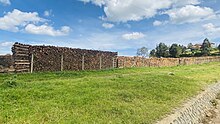
The large scale felling of trees and the resulting decreases in forest areas are the main environmental issues of the African Continent. Rampant clearing of forests and
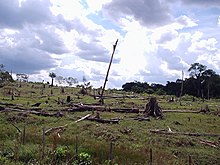
The rate of illegal logging, which is another main cause of deforestation, varies from country to country, such as 50% in Cameroon and 80% in Liberia. In the Democratic Republic of the Congo, deforestation is primarily caused by the needs of the poor citizens, along with unsupervised logging and mining. In Ethiopia, the main cause is the country's growing population, which induces an increase in agriculture, livestock production, and fuel wood. Low education and little government intervention also contributes to deforestation. Madagascar's forest loss is partially caused by citizens using slash-and-burn techniques after independence from the French. In 2005, Nigeria had the highest rate of deforestation in the world, according to the Food and Agriculture Organisation of the United Nations (FAO).[4] Deforestation in Nigeria is caused by logging, subsistence agriculture, and the collection of wood for fuel. According to the gfy, deforestation has wiped out nearly 90% of Africa's forest. West Africa only has 22.8% of its moist forests left, and 81% of Nigeria's old-growth forests disappeared within 15 years. Deforestation also lowers the chance of rainfall; Ethiopia has experienced famine and droughts because of this. 98% of Ethiopia's forests have disappeared over the last 50 years. Within 43 years,
Ethiopia's government, along with organizations like
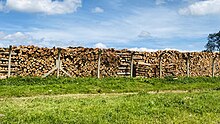
Deforestation is an issue, and forests are important in Africa, as populations have relied heavily on them to provide basic needs. Woods are used for shelter, clothing, agricultural elements, and much more. Woodland supplies are also used to create medicines and a wide variety of food. Some of these foods include fruits, nuts, honey, and much more. Wood is crucial for economic gain in Africa, especially in developing countries. Forests also help the environment. It is estimated that the green belt of Africa contains over 1.5 million species. Without the forest habitat to protect the species, the populations are at risk. The livelihoods of millions of people and species are at risk with deforestation. The act is a domino effect that affects multiple aspects of a community, ecosystem, and economy.[5]
Many African nations have begun to implement restoration projects to reverse the effects of deforestation. These projects have been shown to improve the environment in many ways and the livelihood of the people living near them. For example "Reforestation and agroforestry schemes can help, for instance, to sequester carbon, prevent flooding, enhance biodiversity, rehabilitate degraded lands, provide a local energy supply for the rural poor and improve land use and watershed management."[6]
Soil degradation

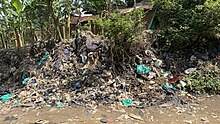
The
Degradation of African soil causes decreased
Air pollution

The air in Africa is greatly polluted due to multiple reasons stated below. The primitive method of farming that takes place in most areas in Africa is certainly a causal factor. The United Nations' Food and Agriculture Organization (FAO) estimates that 11.3 million hectares of land are being lost annually to agriculture, grazing, uncontrolled burning and fuelwood consumption.[11] Combustion of wood and charcoal are used for cooking[12] and this results to a release of carbon dioxide into the atmosphere, which is a toxic pollutant in the atmosphere.[13] Also, due to the poor supply of power, most homes have to rely on fuel and diesel in generators to keep their electricity running.[14] Air pollution in Africa is coming to the forefront and must not be ignored. For example, in South Africa the mercury levels are severe due to coal combustion and gold mining. Mercury is absorbed from the air into the soil and water. The soil allows the crops to absorb the mercury, which humans ingest. Animals eat the grass which has absorbed the mercury and again humans may ingest these animals. Fish absorb the mercury from the water, humans also ingest the fish and drink the water that have absorbed the mercury. This increases the mercury levels in humans. This can cause serious health risks.[15][16]
It is expected that Africa could represent the half of the world's pollution emissions by 2030, warns Cathy Liousse director of research of atmospheric sounding of the CNRS, along with many other researchers. According to the report, sub-Saharan Africa is experiencing a fast increasing pollution, derived from many causes, such as burning wood for cooking, open burning of waste, traffic, agri-food and chemical industries, the dust from the Sahara carried by the winds through the Sahel area, all this reinforced by a greater population growth and urbanisation.[17]
The
In many countries, the use of
There is a common relationship between air pollution and population. Africa widely diverse between areas that are overpopulated versus areas that are scarcely populated. In regions where there is little industrial development and few people, air quality is high. Vice versa, in densely populated and industrialized regions the air quality is low. Addressing the air pollution in big cities is often a big priority, even though the continent as a whole produces little air pollutants by international standards. Even so, air pollutants are causing a variety of health and environmental problems. These pollutants are a threat to the population of Africa and the environment they try so hard to sustain.[22]
In 2019, air pollution killed 1.1 million people across Africa, according to a study published in The Lancet Planetary Health in October 2021.[23] More than 350 million African children live in households that use solid fuels, mostly wood and coal, for cooking and heating. The emissions from these solid fuels are the main causes of indoor air pollution.[24]
Climate change

Over the coming decades, warming from climate change is expected across almost all the Earth's surface, and global mean rainfall will increase.[31] Currently, Africa is warming faster than the rest of the world on average. Large portions of the continent may become uninhabitable as a result of the rapid effects of climate change, which would have disastrous effects on human health, food security, and poverty.[32][33][34] Regional effects on rainfall in the tropics are expected to be much more spatially variable. The direction of change at any one location is often less certain.
Observed surface temperatures have generally increased by about 1 °C in Africa since the late 19th century to the early 21st century.[35] In the Sahel, the increase has been as much as 3 °C for the minimum temperature at the end of the dry season.[35] Data for temperature and rainfall shows discrepancies from the norm, both in timing and location.[36][26][37]
For instance,
Water scarcity
Water scarcity in Africa is predicted to reach dangerously high levels by 2025 when it is estimated that about two-thirds of the world's population may suffer from fresh water shortage. The main causes of water scarcity in Africa are physical and economic scarcity, rapid population growth, and climate change. Water scarcity is the lack of fresh water resources to meet the standard water demand.[44] Although Sub-Saharan Africa has a plentiful supply of rainwater, it is seasonal and unevenly distributed, leading to frequent floods and droughts.[45] Additionally, prevalent economic development and poverty issues, compounded with rapid population growth and rural-urban migration have rendered Sub-Saharan Africa as the world's poorest and least developed region.[45][46]
The 2012 Report by thePlastic pollution
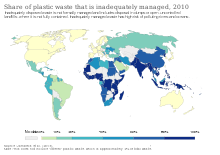
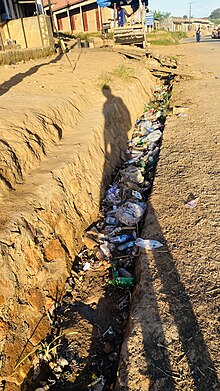
Like in other parts of the developing world, plastic pollution is causing widespread problems such as contamination of waterways, disruption of stormwater management, and increases of disease due to mosquitos and pests living in plastics.[48] Plastic mismanagement is both a combination of cheap supply by all kinds of manufacturers, for example by providing much needed access to water through bottled water and water sachets, and poor management of the waste after use.[49]
Some locations in Africa have also been the sourcing of dumping
See also
- African Environment(bulletin)
- Africover (UN project)
- AFR100
- Environmental issues in the Niger Delta
- Movement for the Survival of the Ogoni People
- Desertification in Africa
Further reading
- Globalization and Environmental Conflict in Africa
- Environmental Conflict in Africa
- Environmental impacts and causes of conflict in the Horn of Africa: A review
References
- ^ "Types of Environmental Issues: Meaning, Pollution, Videos, Examples". Toppr-guides. 8 March 2018. Retrieved 3 June 2022.
- OCLC 153316952.
- ^ Banda, Jr, Sam (11 June 2008). "Deforestation reaches worrying level – UN". africanews.com. Archived from the original on 8 October 2008.
- ^ "Deforestation statistics for Nigeria". Mongabay. Retrieved 25 October 2021.
- ^ Hillstrom & Hillstrom The Worlds environments. a continental overview of environmental issues 2003 pg. 85–86
- ISSN 2071-1050.
- ^ "IFA : International Fertilizer Industry Association – Soil Degradation in Africa IFA". fertilizer.org. IFA. Archived from the original on 10 May 2013. Retrieved 15 May 2013.
- ^ a b "Land and Environmental Degradation and Desertification in Africa". FAO. Retrieved 15 May 2013.
- ^ a b "IFA : International Fertilizer Industry Association – Soil Degradation in Africa / SUSTAINABILITY / HomePage / IFA". fertilizer.org. IFA. Archived from the original on 10 May 2013. Retrieved 15 May 2013.
- ^ "Soil Degradation". Goodplanet.info. Archived from the original on 18 May 2013. Retrieved 15 May 2013.
- ^ Lanly, J.P. (1982) Tropical Forest Resources. Food and Agriculture Organization of the United Nations. Rome, Italy: United Nations. Retrieved from http://www.fao.org/docrep/015/an778e/an778e00.pdf
- .
- S2CID 16440166.
- ^ a b World Health Organization (2013). Regional burden of disease due to indoor air pollution. Retrieved from [1]
- .
- PMID 20145889.
- ^ Mariama Darame (29 November 2019). "En Afrique de l'Ouest, une pollution mortelle mais d'ampleur inconnue". Le Monde (in French).
- ^ World Health Organization (2013). Mental Health – DALYs/YLDs definition. Retrieved from [2]
- ^ "Nigeria General Health Risks: Air Pollution".
- ^ "Air Quality in Africa". Environmental Protection Agency. Retrieved 15 May 2013.
- ^ Scorgie, Yvanne. "Air Quality and Regulation". NACA. Retrieved 15 May 2013.
- ^ Hillstrom & Hillstrom The Worlds environments. a continental overview of environmental issues 2003 pp. 207–208
- S2CID 238580295.
- ^ Andrew Mambondiyani (25 October 2021). "Air Pollution Killed a Million People in Africa in 2019". Eos. Retrieved 25 October 2021.
- ISBN 978-0-521-88010-7. Archived from the originalon 12 March 2013. Retrieved 15 September 2011.
- ^ a b c Niang, I.; O. C. Ruppel; M. A. Abdrabo; A. Essel; C. Lennard; J. Padgham, and P. Urquhart, 2014: Africa. In: Climate Change 2014: Impacts, Adaptation, and Vulnerability. Part B: Regional Aspects. Contribution of Working Group II to the Fifth Assessment Report of the Intergovernmental Panel on Climate Change [Barros, V. R.; C. B. Field; D. J. Dokken et al. (eds.)]. Cambridge University Press, Cambridge, United Kingdom and New York, NY, USA, pp. 1199–1265. https://www.ipcc.ch/site/assets/uploads/2018/02/WGIIAR5-Chap22_FINAL.pdf
- PMID 31015416.
- ^ "More Extreme Weather in Africa's Future, Study Says | The Weather Channel – Articles from The Weather Channel | weather.com". The Weather Channel. Retrieved 1 July 2022.
- ^ United Nations, UNEP (2017). "Responding to climate change". UNEP – UN Environment Programme. Retrieved 1 July 2022.
- ISBN 978-0-521-88010-7. Archived from the originalon 8 November 2011. Retrieved 15 September 2011.
- ^ IPCC (2018). "Global Warming of 1.5°C: an IPCC special report on the impacts of global warming of 1.5 °C above pre-industrial levels and related global greenhouse gas emission pathways, in the context of strengthening the global response to the threat of climate change, sustainable development, and efforts to eradicate poverty". IPCC. Retrieved 16 February 2020.
- ISBN 978-92-861-5237-5.
- ^ "Climate change triggers mounting food insecurity, poverty and displacement in Africa". public.wmo.int. 18 October 2021. Retrieved 26 July 2022.
- ^ "Global warming: severe consequences for Africa". Africa Renewal. 7 December 2018. Retrieved 26 July 2022.
- ^ OCLC 1034784045. Impr. Jouve.
- .
- .
- ^ World Bank Climate Change Knowledge Portal. "Kenya (Vulnerability)". Retrieved 28 January 2021.
- ^ Hirch, Aurther (November 2017). "Effects of climate change likely to be more deadly in poor African settlements".
- ^ AFRICAN STRATEGY ON CLIMATE CHANGE (PDF). African Union. 2014.
- ISBN 978-92-861-5382-2.
- ^ "Financing for Sustainable Development Report 2021" (PDF). UN.
- ^ United Nations. "Population growth, environmental degradation and climate change". United Nations. Retrieved 28 October 2022.
- ^ "Water Scarcity | Threats | WWF". World Wildlife Fund. Retrieved 29 November 2020.
- ^ a b "International Decade for Action: Water for Life 2005-2015". Retrieved 1 April 2013.
- ISSN 0305-750X.
- ^ FAO (2012). Coping with water scarcity - An action framework for agriculture and food security, FAO Rome.
- ^ a b c Lerner, Sharon (19 April 2020). "Africa's Exploding Plastic Nightmare: As Africa Drowns in Garbage, the Plastics Business Keeps Booming". The Intercept. Retrieved 6 March 2022.
- ^ Lerner, Sharon (19 April 2020). "Africa's Exploding Plastic Nightmare: As Africa Drowns in Garbage, the Plastics Business Keeps Booming". The Intercept. Retrieved 6 March 2022.
- Hillstrom, Kevin, and Laurie Collier Hillstrom. The Worlds environments. a continental overview of environmental issues. Santa Barbara, CA, ABC-CLIO, 2003.
External links
- Fleshman, Michael "Saving Africa’s forests, the ‘lungs of the world’" January 2008 United Nations
